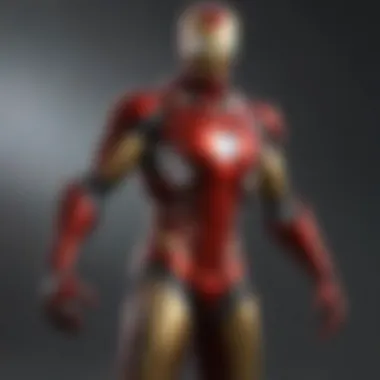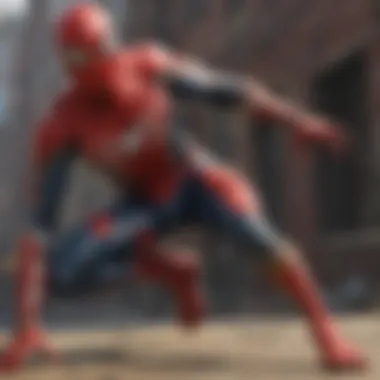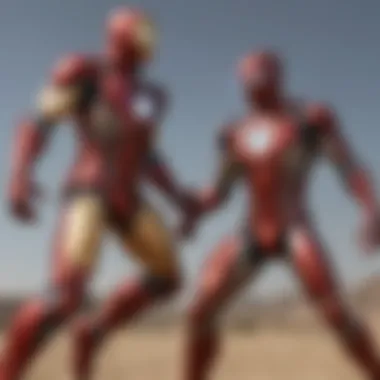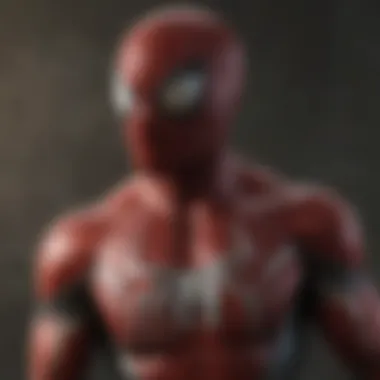Comparing Iron Man's Suit and Spider-Man's Powers


Intro
In the captivating realm of comic book superheroes, few characters stand out quite like Spider-Man and Iron Man. While they both embody the ideals of heroism and sacrifice, their methods and the technologies they rely on couldn't be more different. Spider-Man, with his organic powers, agility, and street-smart wisdom, represents the everyman hero, while Iron Man, with his technological prowess, showcases the peak of human ingenuity. This comparison not only takes a look at their abilities but also reveals deeper themes of innovation and resilience found in both characters.
The Iron Man suit, invented by Tony Stark, is a marvel of engineering, packed with features that redefine the superhero genre. On the flip side, Spider-Man relies on his natural gifts to swing through the concrete jungle with ease. Both heroes face daunting challenges and formidable villains, making their journeys significant not just for themselves but for the audience as well.
Let's dive into each character separately to understand the essence of their abilities, their growth over time, and the rich stories they tell in various media.
Foreword to Spider-Man and Iron Man
In the world of comics and film, few characters have left as much of a mark as Spider-Man and Iron Man. These two heroes encapsulate the very essence of human aspiration, wandering through complex narratives filled with heroism, failure, and growth. Their stories are not just about powers and suits; they are rich tapestries of culture, technology, and identity that span generations.
Understanding these characters is essential in exploring the impact they have had on popular media. Spider-Man, with his relatability and the burdens he carries, reflects the trials of everyday life, inviting audiences to connect deeply with his struggles and triumphs. Iron Man, on the other hand, represents the pinnacle of human innovation and ambition, showcasing the possibilities and perils of technology.
These opposing yet complementary forces provide a foundational lens through which we can analyze broader themes in superhero narratives. Their differing approaches to villainy, responsibility, and what it means to be a hero invite readers to ponder critical questions.
Cultural Impact of Spider-Man
Spider-Man has woven himself into the very fabric of cultural consciousness. Since his inception in the 1960s, he has resonated with readers on multiple levels. His iconic catchphrase, "With great power comes great responsibility," underscores moral integrity and the weight of choices we each make. Many see him as a reflection of their own high school experiences — navigating friendships, romance, and the struggle for identity.
Over the years, Spider-Man has inspired various adaptations ranging from animated series to blockbuster films, making him accessible to fans of all ages. His inclusion in the Marvel Cinematic Universe has revived and reshaped his image, introducing him to a new generation that finds hope and inspiration in his enduring misadventures.
- Spider-Man symbolizes youth and empowerment.
- He serves as a metaphor for personal growth in challenging times.
- His relationships with other characters enrich his narrative and highlight themes of loyalty and sacrifice.
Cultural Impact of Iron Man
Iron Man’s charm lies significantly in Tony Stark's complexity. As a wealthy industrialist and a self-proclaimed genius, Stark’s character represents the duality of technology’s potential. While he creates the eponymous suit, allowing him to transform into Iron Man, he also faces the moral dilemmas that come with such power.
Since appearing on the scene, Iron Man has catalyzed conversations about the ethics of technology and personal accountability. The evolution of his character from a businessman focused purely on profit to a hero willing to sacrifice everything for the greater good is both compelling and relevant to contemporary society's own struggles with technological advancement.
- Iron Man has redefined what it means to be a superhero in modern narratives.
- His character arc illustrates themes of redemption and responsibility in the face of past misdeeds.
- Stark's relationship with his suit raises fascinating questions about autonomy and human versus artificial enhancement.
Both Spider-Man and Iron Man, while distinct in their abilities and ethics, symbolize broader currents in society. They reflect our fears, hopes, and the very nature of what it means to be human in an ever-evolving world.
Anatomy of the Iron Man Suit
The analysis of Iron Man's suit serves as a pivotal section of this exploration, casting light on how technology marries functionality and enhances heroism. This armor represents not just a layer of protection but also a canvas for Tony Stark's brilliance and creativity. Each element of the suit is meticulously designed to address specific challenges, showcasing a fascinating interplay between human ambition and mechanical prowess. It offers a clear view into the capabilities and ingenuity that define Iron Man while drawing a contrast with the organic abilities of Spider-Man.
Design Evolution of the Armor
Over the years, the Iron Man suit has evolved remarkably, reflecting both the technological advancements in the real world and the narrative needs of comic books and films. Initially, Tony Stark's armor appeared bulky and rudimentary in form, almost like a walking tank. This primitive version highlighted his vulnerability and need for survival in hostile environments, as seen in the early comics.
However, as the story progressed, Stark's designs became sleeker and more sophisticated, mirroring the advancements in technology. The armors transitioned into a manifestation of Stark's intelligence—an external representation of his journey from a weapons manufacturer to a superhero. The introduction of Nanotechnology in later iterations allows for rapid restructuring during battle, showcasing the epitome of adaptability and innovation.
Key Features of the Suit
The Iron Man suit boasts many features that set it apart from ordinary superhero gear. Each feature is integrated not only for combat efficiency but also for a multi-dimensional approach to heroism. Let’s highlight three fundamental characteristics that define the functionality of this marvel.
Flight Capabilities


Flight is one of the most exciting aspects of Iron Man's suit. This feature serves as both a tactical advantage and a way to transcend conventional limits. With repulsor technology, Stark can soar through the skies, maneuvering swiftly to respond to emergencies or engage foes. The ease of flight allows Iron Man unfettered access to conflict zones, affording him the opportunity to intervene where others might struggle to reach.
One unique aspect of this capability is the suit's precision control during flight. Unlike other characters relying on web-slinging or leaps, Iron Man can hover and adjust his altitude seamlessly, making it effective for strategic positioning. However, the trade-off is that this reliance on technology leaves him vulnerable to electronic disruptions.
Superhuman Strength
Another remarkable feature of the Iron Man suit is its superhuman strength. The suit amplifies Tony Stark's strength exponentially, enabling him to lift weights many times his own body mass and engage in combat with formidable opponents. This enhancement elevates his physical prowess beyond the average human, allowing him to tackle challenges that would otherwise be insurmountable.
A critical element of this strength lies in the suit's exoskeleton design, which distributes weight and force optimally. While this augmentation offers Iron Man a slight edge over rivals, it comes at a cost; the technology doesn't replace Stark’s human stamina. Prolonged engagement can lead to fatigue, proving that even his might has limitations.
Advanced Weaponry
Iron Man's suit is not just a protective shell; it’s an arsenal of advanced weaponry. From repulsor beams to missile launchers, the suite of tactical options provides Stark with significant firepower. This versatility allows him to adapt to a variety of threats, whether faced with a simple criminal or a super-villain team.
The distinguishing feature of this advanced weaponry is its precision targeting system, which can analyze threats in real-time and adjust accordingly. The integration of AI assists in decision-making processes, enhancing Stark's effectiveness in combat situations. Nevertheless, this reliance on technology to engage enemies raises questions about moral implications—especially regarding collateral damage and the ethics of using lethal force.
"The Iron Man suit is a blend of genius and ambition, depicting a man who transforms vulnerability into strength through sheer innovation."
Thus, examining the anatomy of the Iron Man suit offers profound insights into Tony Stark's character. Every piece of technology and design serves to underscore a broader narrative about human potential and the consequences of wielding such power.
Spider-Man's Unique Skills
Spider-Man's abilities go beyond mere physical prowess; they are a tapestry of skills that intertwine with his character and narrative purpose. These powers make him a quintessential hero, embodying themes of resilience and adaptability. In this section, we'll dissect these unique skills and examine how they magnify his significance in the superhero pantheon, especially in contrast to Iron Man's technological might.
Organic Web-Slinging
Spider-Man's web-slinging is one of his signature traits, separating him from many other superheroes. Unlike many portrayals where heroes rely on gadgets or tools, Peter Parker’s ability to generate webs organically represents both a blessing and a burden.
The ability to shoot webs acts as an extension of his creativity and agility. When he swings through New York City, it's not just transportation; it's an expression of freedom and mastery of his environment. Moreover, the webs aid him in combat, allowing him to immobilize foes or create makeshift barriers. While Iron Man may have mechanical innovations, Spider-Man’s webs symbolize instinct—raw and unfiltered.
Benefits of Organic Webbing:
- Instinctive Use: Spider-Man can generate webs anytime, without needing to reload or worry about gadgets failing.
- Versatility: The webs can be crafted into various forms, from grappling hooks to sticky nets.
- Stealth: Webs can serve to conceal and surprise, adding a tactical edge unseen in traditional armament.
Agility and Reflexes
The agility and reflexes that Spider-Man possesses are nothing short of extraordinary. His physicality allows him to perform acrobatic feats, outmaneuvering opponents with grace that contrasts starkly with Iron Man's reliance on armor.
This enhanced agility enables him to dodge bullets, evade physical attacks, and launch counterattacks from any angle. When facing overwhelming odds, it’s often his ability to think on his feet and adapt to ever-changing scenarios that tips the scale in his favor. In a fight, he dances around enemies, bouncing off walls and using his surroundings to his advantage, all while remaining deeply attuned to his emotional core.
Key Aspects of His Agility:
- Spider-Like Movement: Much like his namesake, Spider-Man can scale walls and leap great distances.
- Dynamic Combat: His reflexes enable fluid, unpredictable movements during battles, making him a challenging target.
- Navigational Skill: His natural agility allows for rapid movement through complex environments, enabling escape and tactical maneuvers.
Spider-Sense
Arguably, Spider-Sense is one of Spider-Man's most unique abilities. This sixth sense warns him of impending danger, offering him an almost precognitive edge in combat. While Iron Man relies on tech scans and analytical systems, Spider-Man’s instinct is deeply personal, grounded in his experiences and emotions.
This heightened awareness enables him to react swiftly, making decisions in the blink of an eye—decisions that often determine life or death for those around him. Thus, Spider-Sense isn’t just a power; it’s a catalyst for his heroism, embodying the notion that being a hero means being aware of others’ needs and threats.
Significance of Spider-Sense:


- Intuition Over Technology: Unlike Iron Man's gadgets, Spider-Sense is innate, emphasizing instinct over invention.
- Life-Saving Ability: It allows him to dodge bullets and evade attacks, ensuring he stays one step ahead.
- Emotional Connection: The power reflects his internal struggles, often paralleling his personal life crises.
"With great power comes great responsibility."
This mantra encapsulates Spider-Man’s journey, where his skills serve greater purposes than mere combat, fueling his relentless pursuit of justice.
In summary, Spider-Man's unique skills represent a stark departure from Iron Man's reliance on technology. Each ability highlights an essential aspect of Spider-Man as a character: deeply human, instinctual, and resilient. These skills propel him into the hearts of audiences while ensuring his place in the broader superhero narrative.
Character Comparisons
Examining character comparisons between Spider-Man and Iron Man is essential in understanding the implications each hero represents in the broader superhero narrative. This section serves to not only highlight their unique strengths and weaknesses but also to provoke thought on the moral and ethical underpinnings of their powers and personalities. Each character embodies different archetypes, allowing the audience to connect with diverse facets of heroism and innovation, making their contrasts all the more significant.
The Technology vs. Natural Abilities Debate
At the heart of the character comparison lies the debate between technology and natural abilities. Iron Man, who dons a suit equipped with cutting-edge tech, exemplifies human ingenuity. This armored figure relies on a carefully engineered creation, which enhances his physical capabilities beyond natural limits. The Iron Man suit showcases a myriad of features that grant Tony Stark unprecedented advantages such as supersonic flight and programmable weapons systems. It’s easy to see how this technology not only makes him powerful but also seems to symbolize the potential of human achievement through science and engineering.
In contrast, Spider-Man, with his organic abilities, embodies the raw essence of human capability. His skills come without the aid of technological enhancements—aside from his web shooters, which are a product of his intellect. This puts him in a more relatable and human light. Spider-Man represents those who find strength through personal determination and adaptation. The argument often presented by fans is whether these natural abilities are inherently superior to technology or if they simply represent a different sort of strength.
Personality Contrasts
Peter Parker’s Relatability
Peter Parker’s relatability serves as one of his most compelling traits. He is a character rooted in real-world struggles, balancing life as a high school student, part-time photographer, and vigilant superhero. His financial woes, academic pressures, and social anxiety create a character who resonates with audiences of all ages. This relatability makes him a lasting figure in the realm of superhero narratives.
His innate qualities—humility, empathy, and resilience—stand out, making Peter a symbol of perseverance. By emphasizing his day-to-day challenges, the narrative invites readers to see themselves in him and inspires them to confront their own hurdles. Whereas Tony Stark’s journey often revolves around self-improvement and redemption, Peter’s journey is more about constant growth and adaptation amid adversity.
Tony Stark’s Arrogance
In striking contrast, Tony Stark’s arrogance sets him apart. This characteristic, while a source of frustration at times, makes for compelling storytelling. His self-assured nature often leads him to prioritize ambition over caution, revealing the complexities of his choices. The charismatic billionaire's bravado can be seen as a shield against his insecurities, making him a multi-dimensional character who grapples with his own personal demons.
Tony’s arrogance lays the groundwork for significant character development throughout the Marvel Cinematic Universe. His journey from a narcissistic genius to a selfless hero embodies a sort of redemption arc that can captivate audiences. Yet, it also serves as a cautionary tale about trusting in one's own abilities too blindly.
Heroism in Different Forms
The differences between Spider-Man and Iron Man extend to their definitions of heroism. Spider-Man often relies on intuition and heartfelt decisions, whereas Iron Man engages in calculated risk assessments that highlight the interplay between morality and technology.
Both characters represent valuable lessons about responsibility, one derived from personal conviction and another from the weight of innovation. Their heroism is expressed not just through acts of bravery but also through the choices they make in their daily lives, showing audiences that heroism can take many forms.
"With great power comes great responsibility"—a mantra that encapsulates the ideological divide between Peter Parker and Tony Stark.
Narrative Functions in Comics and Films
Understanding the narrative functions in comics and films is an essential aspect when discussing characters like Iron Man and Spider-Man. In major superhero narratives, every ability or technological wonder serves to propel the story in a certain direction. This become particularly evident when contrasting an armored superhero, like Iron Man, with a character whose prowess is derived from natural abilities like Spider-Man. Reinforcing the behaviors and metaphors embedded in these stories creates greater resonance with an audience that often sees reflections of themselves or their societal challenges.
Spider-Man's Role in Team Dynamics
Spider-Man's unique abilities and relatable persona lend a crucial element to team dynamics within the superhero realm. Unlike Iron Man's advanced technology, Peter Parker brings a human touch to team structures, illustrating a blend of humor and depth. His struggles with balancing personal life and hero duties reflect a sentiment that resonates profoundly. When placed alongside experienced heroes, he forms a bridge, highlighting the importance of community and collaboration.
- Youthful Perspective: Spider-Man often embodies youthful enthusiasm, which can uplift group morale, showing that hope is not exclusively for the seasoned.
- Human Connections: His friendships often serve to clarify the moral dilemmas faced by the group, emphasizing the need for teamwork in overcoming challenges.
A prime example of Spider-Man's vital role in team dynamics can be seen in the Avengers series. His interactions with seasoned heroes contribute significantly to the moral landscape, showing how vulnerability coexists with heroics.
Iron Man as a Central Figure in the MCU


Iron Man’s significance in the Marvel Cinematic Universe cannot be overstated. His introduction to the MCU in 2008 set the stage for a new era of superhero films that emphasized character development intertwined with cutting-edge technology. Iron Man represents innovation—not just in the form of his tech but in storytelling itself. The character resonates with an audience that values intellectual prowess and self-made success.
- Technological Symbolism: Iron Man's suit exemplifies the modern human reliance on technology, as well as the ethical implications of its use. There's an inner struggle, particularly in films like Iron Man 3, where Tony grapples with his creations and their impacts on personal relationships.
- Leadership Qualities: As a leading figure in the Avengers team, Iron Man’s character functions as the catalyst for collective action, bringing together diverse characters from different backgrounds around common goals.
"The arc of Iron Man is as much about the evolution of technology as it is about the evolution of the hero within."
Each function in these narratives interplays to create a captivating storyline that reflects broader themes present in society, from ethical quandaries linked to technology to the value of human connections. As such, Spider-Man and Iron Man serve not just as heroes, but as vessels through which audiences can explore complex ideologies and moralities.
Symbolism in Hero Ideologies
In the expansive universe of superheroes, the ideologies represented by figures like Iron Man and Spider-Man encapsulate profound themes of heroism and moral responsibility. These characters serve not just as titans of strength and ingenuity, but as beacons of deeper societal ideals. The contrast between Iron Man's technological prowess and Spider-Man's organic abilities sheds light on the divergent philosophies of innovation and heritage, respectively.
Redemption and Responsibility
At the heart of Spider-Man's narrative lies the concept of redemption. Peter Parker, a regular kid turned superhero, embodies the struggle against personal guilt and loss. His mantra, "With great power, comes great responsibility," is not merely a catchy line; it resonates as a life lesson and an ongoing battle. He faces the repercussions of his powers, often torn over the lives he could save versus the ones he couldn’t. This continual quest for redemption shapes him into a figure of hope and resilience.
Contrast this with Tony Stark, the brilliant mind behind the Iron Man suit. Stark’s journey reflects a different kind of responsibility rooted in innovation. Initially, he thrives on ambition and wealth, creating weapons that wreak havoc. However, after a life-altering experience, he pivots. Stark’s Iron Man suit symbolizes the redemption of a once-reckless inventor into a responsible adult who fights for good. He learns that true power isn’t just technical; it involves the weight of one’s actions and their impact on others.
This interplay between Spider-Man's burdens and Iron Man's growth illustrates how both characters navigate their responsibilities in unique ways, showcasing that heroism entails facing one’s flaws and striving for betterment.
Innovation and Progress
Iron Man signifies a deeper narrative around innovation and progress. Stark’s scientific brilliance is not just his utility but an inspiring idea: technology can be a force for good. The Iron Man suit, with its intricate engineering and cutting-edge capabilities, acts as a metaphor for the potential of human creativity. Stark’s inventions remind us that progress is a double-edged sword; while it can lead to destruction, it can also pave the way for salvation.
The evolution of the Iron Man suit mirrors the changing landscape of technology in modern society. Each upgrade, from the bulky Mark I to the sleek Mark LXXXV, portrays a journey towards excellence and sophistication. Stark's commitment to innovation raises questions about ethical responsibility and the ultimate purpose behind technological advancement.
In contrast, Spider-Man embodies the idea that some abilities and powers come inherently, requiring no machinery or advanced tech. His agility and spider-sense highlight the beauty of natural abilities and resilience against adversity.
Both characters emphasizing innovation and natural prowess reflect society’s broader aspirations. They urge audiences to consider how technology and innate skills can converge to create positive change in the world.
"The stories we attach to our heroes reflect the values we hold dear and the legacies we wish to create."
In summary, the ideologies represented through Iron Man and Spider-Man capture essential truths about our relationship with modernity and morality. These contrasting frameworks not only enrich narratives but also inspire us to engage with our realities thoughtfully.
Epilogue: The Significance of Their Legacy
When it comes to understanding the lasting impact of Spider-Man and Iron Man, it’s essential to dissect their legacies. Each character has carved out a distinct and vital niche within the superhero genre, influencing not only the realm of comic books but also the various adaptations that make their ways to screens both big and small. In many ways, these figures embody the values and struggles of their eras, making their stories relevant even decades after their inception.
Both characters resonate due to their unique narratives. While Spider-Man stands as a symbol of youth and responsibility, navigating the challenges of growing up with immense powers, Iron Man embodies the archetype of the flawed genius — a testament to human ingenuity mixed with ethical dilemmas. Their contrasting approaches to heroism provide rich material for discussion, especially in a world where technological advancements and social responsibilities are constantly at odds.
Enduring Relevance in Modern Media
Even in today's fast-paced world, the relevance of Spider-Man and Iron Man endures with remarkable strength. The rise of streaming platforms has brought new life into their stories, making them accessible to a wider audience. The cinematic universe, particularly the Marvel brand, catapulted these characters into global icons, with box office successes showcasing their enduring appeal.
- Thematic Resilience: Themes of courage, sacrifice, and the moral complexities that come with power are more pertinent than ever, often reflecting societal concerns.
- Diverse Representations: The inclusivity in recent portrayals, especially in adaptations like Spider-Man: Into the Spider-Verse, reinforce that these heroes are not just for the comic book aficionados but for everyone.
"The heart of a hero beats in the soul of the story; it echoes beyond the pages into modern ideals."
This shift signifies a not just a passing trend but a continual evolution that captures the zeitgeist of contemporary society, ensuring that both Iron Man and Spider-Man remain relatable figures.
Future of Spider-Man and Iron Man in Popular Culture
Looking ahead, the future seems bright for both Spider-Man and Iron Man, despite their varying trajectories in popular culture. Spider-Man remains a versatile character, with possibilities for new storylines and adaptations that explore different aspects of his character. From various incarnations in animation, live-action films, and even gaming, there's no shortage of new stories to tell.
Iron Man's legacy also appears secure. With the character’s extensive lore and existing technology, new narratives can delve into alternate timelines or explore newer generations wielding the tech. The potential for crossover stories remains boundless, exploring what if scenarios that could invigorate interest once again.
As these characters push forward in their narratives, they continue to challenge our perceptions of heroism. The enduring nature of their legacies suggests that they will adapt and thrive, inspiring future generations and reflecting the aspirations and struggles of our ever-changing world. No doubt, Spider-Man and Iron Man will navigate their ways into the hearts of many to come.







